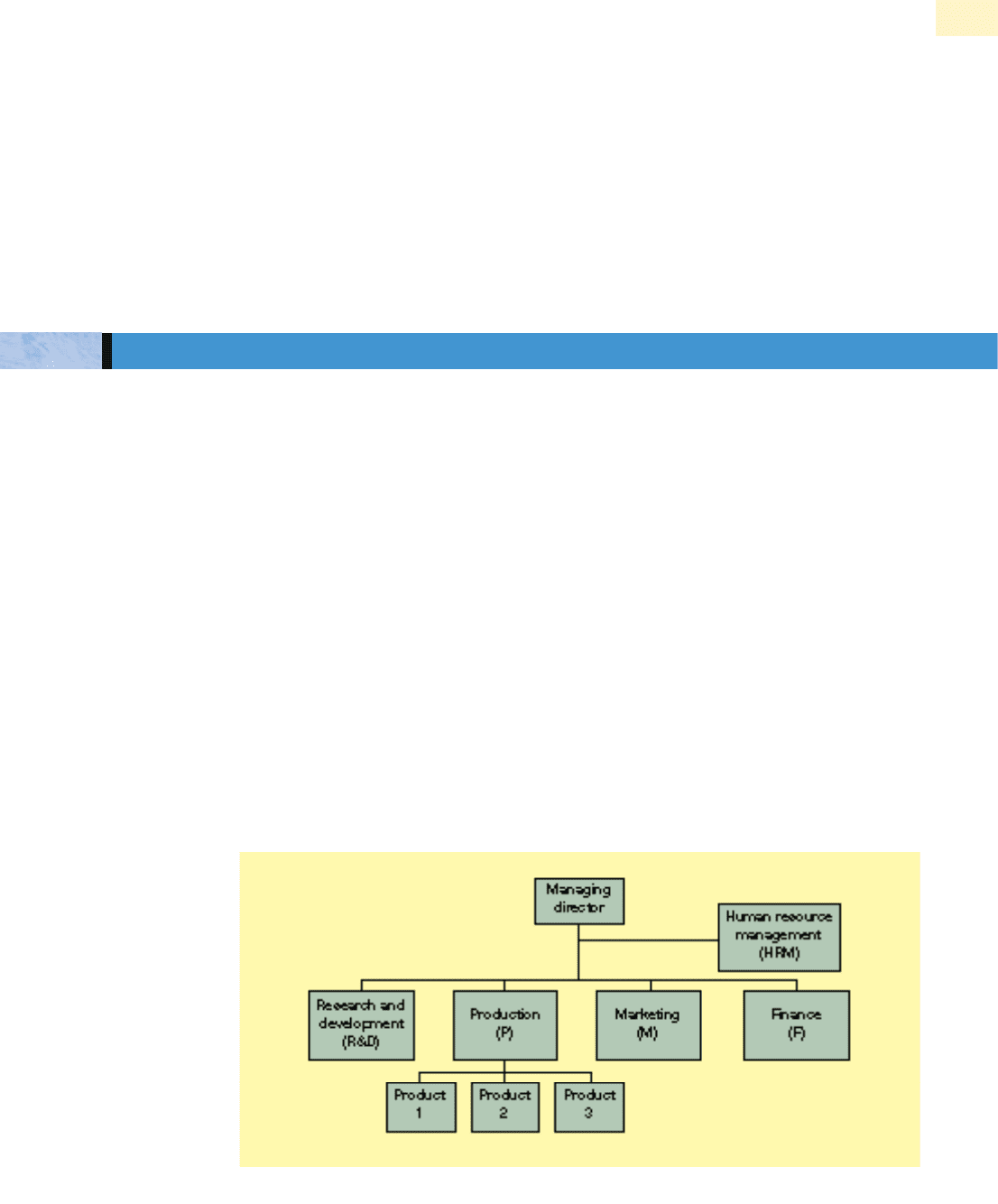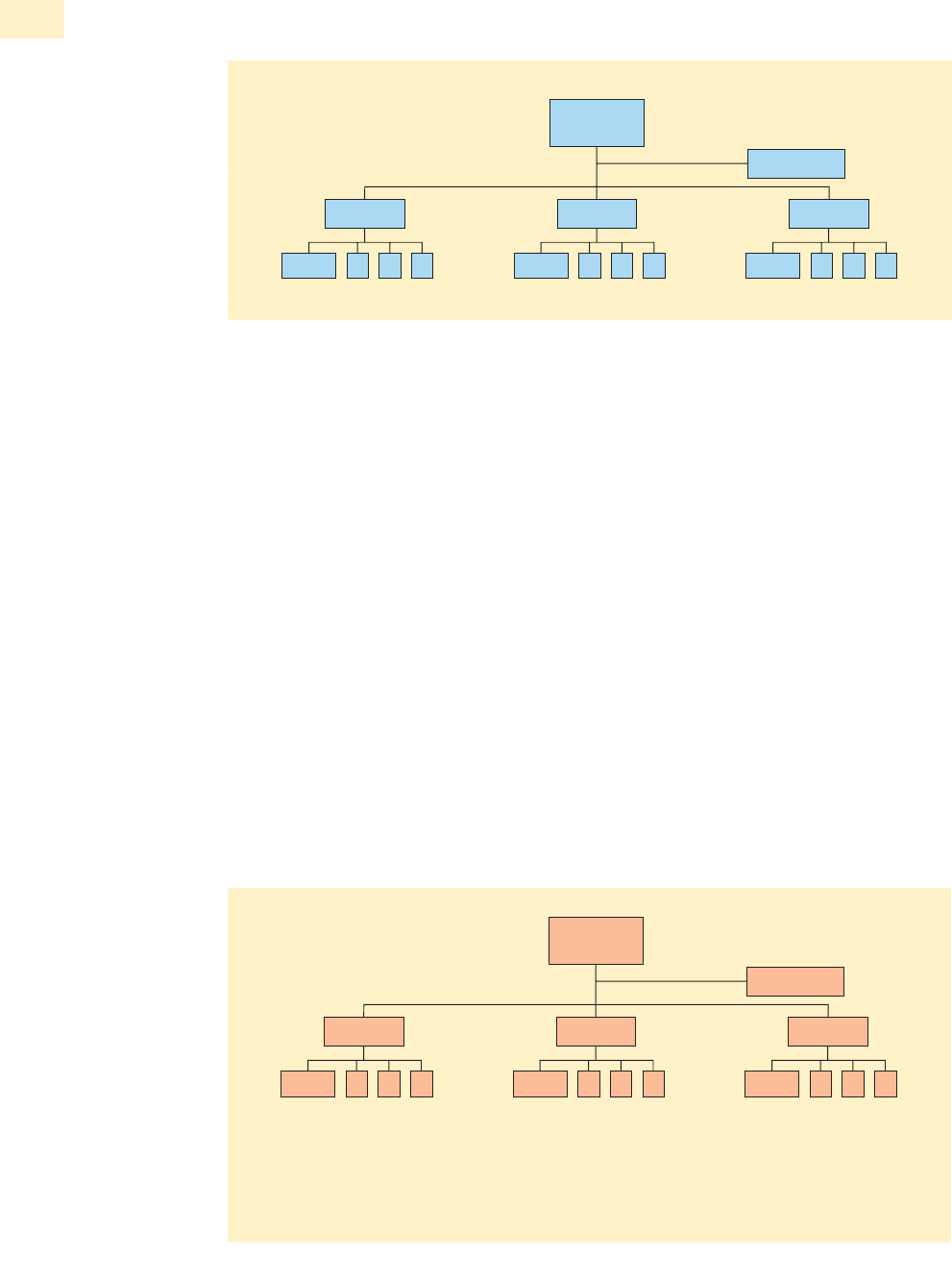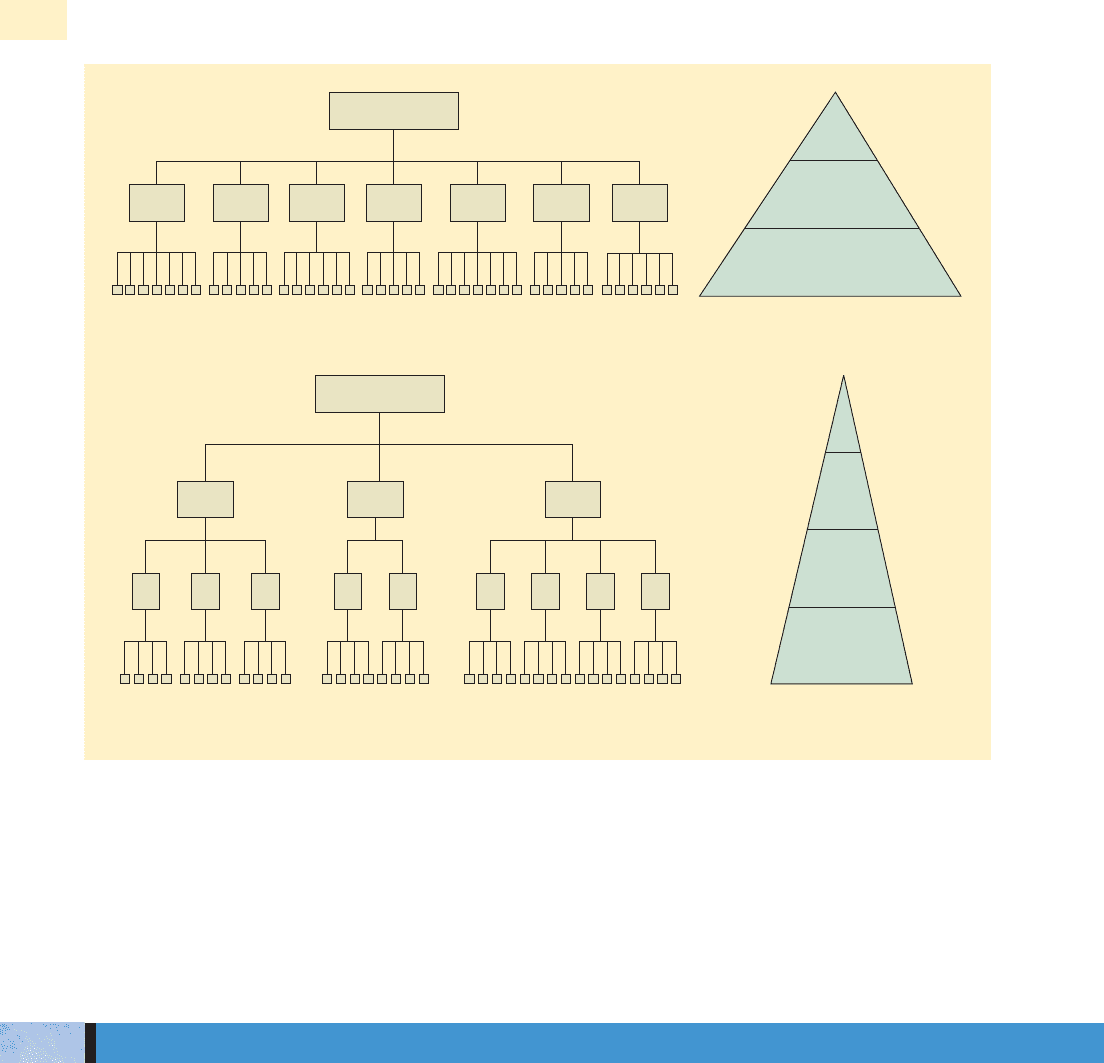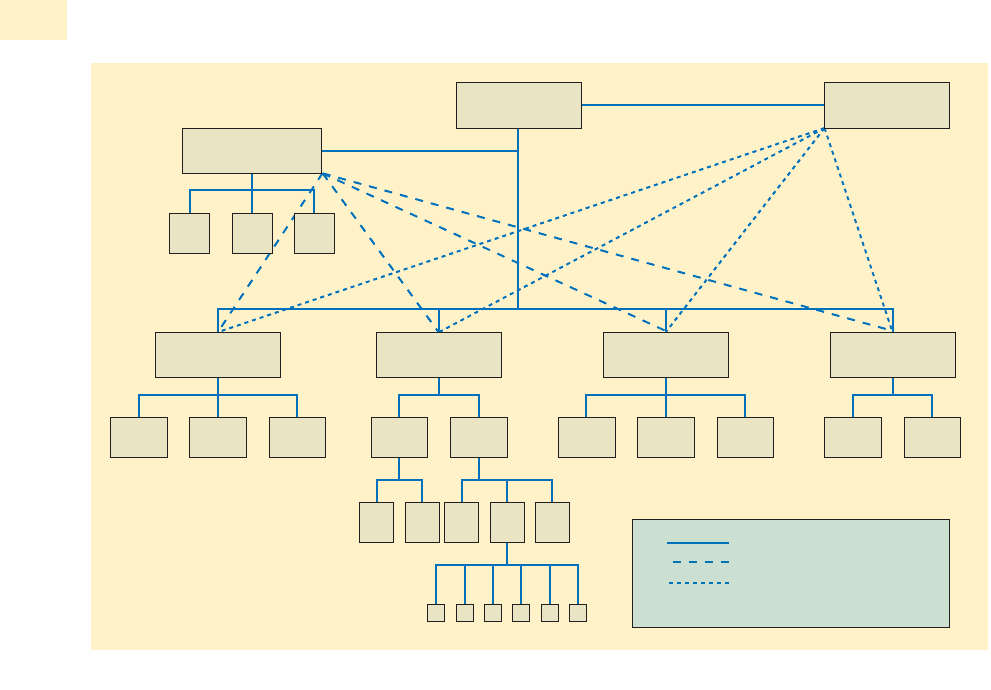Mullins L.J. Management and organisational behaviour, Seventh edition
Подождите немного. Документ загружается.


According to Woodward, activities concerned with raising funds for the business, keep-
ing accounts and determination of financial policy are task functions. Management
accounting, however, concerned with prediction and control of production administra-
tion, is an element function, and is primarily a servicing and supportive one.
Relationships between the accountants and other managers seemed better when the
two functions were organisationally separate. This was noticeable especially in divi-
sionalised organisation when each product division had its own accounting staff
providing line managers with the necessary information to control their own depart-
ments. In these cases the task function of finance was completely divorced from the
element function of management accounting in which the servicing and supportive
role is of most importance.
Within the formal structure of an organisation work has to be divided among its mem-
bers and different jobs related to each other. The division of work and the grouping
together of people should, wherever possible, be organised by reference to some
common characteristic which forms a logical link between the activities involved. It is
necessary to maintain a balance between an emphasis on subject matter or function at
higher levels of the organisation, and specialisation and concern for staff at the opera-
tional level.
Work can be divided, and activities linked together, in a variety of different ways.
The most commonly used basis for grouping activities is according to specialisation,
the use of the same set of resources, or the shared expertise of members of staff. It is a
matter for decision in each organisation as to which activities are important enough to
be organised into separate functions, departments or sections. Work may be depart-
mentalised and based, for example, on differentiation between task and element
functions, discussed above. (See Figure 15.4.)
In division by product or service, the contributions of different specialists are inte-
grated into separate, semi-autonomous units with collective responsibility for a major
part of the business process or for a complete cycle of work. This form of grouping is
more common in the larger diversified organisations and may be used as a means of
CHAPTER 15 ORGANISATION STRUCTURE AND DESIGN
605
THE DIVISION OF WORK
Major purpose
or function
Figure 15.4 Division of work by major purpose or function
Product or
service

sub-dividing departments into sections. An example is the bringing together of all
activities concerned with a particular production line, product or service. (See Figure
15.5.) Another example is a hospital where medical and support staff are grouped
together in different units dealing with particular treatments such as accidents and
emergency, medical or surgery. With grouping by product or service there is a danger
that the divisions may attempt to become too autonomous, presenting management
with a problem of co-ordination and control.
In division by location, different services are provided by area or geographical bound-
aries according to particular needs or demands, the convenience of consumers, or for
ease of administration. (See Figure 15.6.) Examples are the provision of local authority
services for people living in a particular locality; the siting of hospitals or post offices;
the provision of technical or agricultural further education in industrial or rural areas;
sales territories for business firms; or the grouping of a number of retail shops under an
area manager. Another example is provided by organisations with multi-site working
and the grouping of a range of similar activities or functions located together on one
site. The improvement in communications, particularly telecommunications, tends,
however, to reduce the importance of location. For example, administrative staff may
no longer need to be located within the main production unit.
606
PART 6 ORGANISATIONAL STRUCTURES
Location
Managing
director
HRM *
Product 1
R&D P M F
Product 2
R&D P M F
Product 3
R&D P M F
Figure 15.5 Division of work by product or service
*In the case of division of work by product or service, or by geographical location, it is possible that certain
aspects of support services, such as human resource management, may also be assigned to individual units
of the organisation. However, the main responsibility of the HRM manager, as a separate entity, is to provide a
specialist advisory service to all unit managers and to ensure implementation of HRM policy throughout the
organisation as a whole. Responsibility for the main aspects of the HRM function is likely to remain, therefore,
in a direct line of authority from top management.
Managing
director
HRM *
Area A
R&D P M F
Area B
R&D P M F
Area C
R&D P M F
Figure 15.6 Division of work by location

Division may be according to the nature of the work performed where there is some
special common feature of the work such as the need for speedy decisions, accuracy,
confidentiality/security, or where local conditions require first-hand knowledge not
immediately available elsewhere. Another example may be the grouping together of
equipment or machinery which is noisy or which produces dust, fumes or unpleasant
odours. When common processes are used in a range of different activities, this may
also be used as the basis of division. This method of grouping includes, for example,
the decision whether to establish a centralised resource centre for all departments of
the organisation, or to allow each department to have its own service. With manufac-
turing industries a range of products may pass through a common production facility
or configuration of machines which may be grouped together in a single unit – for
example, a batch production engineering firm having departments based on like skills
or methods of operation.
Division may be according to time scales, for example, shift working and the extent to
which different tasks should be undertaken by different shifts. In a further education
college there may be separate departments or groupings to deal with the different
needs of full-time day students and part-time evening students. Another example of
activities grouped according to time is in a hotel. Activities in the kitchen tend to be
short term, especially when guests in the restaurant are waiting to be served, and a
range of different tasks have to be co-ordinated very quickly. Other activities, for ex-
ample market research and forecasting future room occupancy, are longer-term
decisions, and subject to different organisational requirements.
The allocation of duties and responsibilities may be according to experience, or where
a particular technical skill or special qualification is required – for example, the divi-
sion of work between surgeons, doctors and nurses; or between barristers, solicitors and
legal executives. Another example is the sharing of routine work processes among
members of a supervised group. In smaller organisations the allocation of work may be
on an ad hoc, personal basis according to the knowledge and skills contributed by indi-
viduals. Work may also be planned deliberately to give a variety of tasks and
responsibilities to provide improved job satisfaction or to assist in the training of staff.
Separate groups may be established to deal with different consumer requirements – for
example, the division between trade or retail customers, or between home or export
sales. In hospitals there are different groupings dealing with, for example, patients in the
gynaecology, geriatric and children’s wards. In large clothes shops there may be separate
departments for men’s, women’s and children’s clothing. Government departments are
often grouped by this method and work is divided according to for whom the services are
provided – for example, the unemployed, low-pay families, students, young people or
senior citizens. A further example is the provision of canteen services which may be
grouped by customer demand according to price, range or standard of meals available,
speed of service, or type of customer; this gives rise to separate facilities such as the direc-
tors’ dining room, or for staff and students in educational establishments.
Combination of groupings
These different ways of dividing work can be combined in various forms and most
organisations will contain examples of alternative combinations for grouping activi-
ties. Some activities might be grouped according to one method and other activities
according to a different method. Decisions on the methods of grouping will include
considerations of:
CHAPTER 15 ORGANISATION STRUCTURE AND DESIGN
607
Nature of
the work
performed
Common time
scales
Staff employed
Customer or
people to be
served

■ the need for co-ordination;
■ the identification of clearly defined divisions of work;
■ economy;
■ the process of managing the activities;
■ avoiding conflict; and
■ the design of work organisation which takes account of the nature of staff employed,
their interests and job satisfaction.
Management must decide upon the most significant factors which will determine the
methods for division of work and linking of activities appropriate to the changing cir-
cumstances within the particular organisation.
One particular problem which arises from division of work and grouping of activities is
the extent of centralisation or decentralisation. Most organisations necessarily involve a
degree of decentralisation arising from such features as an increase in size, the geo-
graphical separation of different parts of the organisation, or the need to extend
activities or services to remote areas. Our main concern is with decentralisation or
devolution in terms of specific delegation or empowerment to sub-units or groups
within the organisation such that they enjoy a measure of autonomy or independence.
The advantages often claimed for centralisation tend to relate to economic and
administrative considerations. However, such advantages frequently are not realised
fully, and do not lead to an actual improvement in service. There are a number of con-
trary arguments against centralisation, including the criticism that it creates a more
mechanistic structure and may result in lengthening the chain of command. There are
also positive arguments, which tend to relate more to behavioural considerations, in
favour of decentralisation. (See Figure 15.7.)
608
PART 6 ORGANISATIONAL STRUCTURES
CENTRALISATION AND DECENTRALISATION
Advantages of centralisation
• the easier implementation of a common policy for the organisation as a whole;
•providing a consistent strategy across the organisation;
•preventing sub-units becoming too independent;
• making for easier co-ordination and management control;
• improved economies of scale and a reduction in overhead costs;
•greater use of specialisation, including better facilities and equipment;
• improved decision-making which might otherwise be slower and a result of compromise because
of diffused authority.
Advantage of decentralisation
• enables decisions to be made closer to the operational level of work;
• increased responsiveness to local circumstances;
• improved level of personal customer service;
• more in keeping with developments in flatter and more flexible structures;
• support services, such as adminstration, are more likely to be effective if provided as close as
possible to the activities they are intended to serve;
•provides opportunities for training and development in management;
• usually, it has an encouraging effect on the motivation and morale of staff.
Figure 15.7 Advantages of centralisation or decentralisation

The advisability of decentralisation must be considered in terms of: the nature of the
product or service provided; policy-making; the day-to-day management of the organi-
sation; and the need for standardisation of procedures, or conditions or terms of
employment of staff. Decentralisation generally tends to be easier to implement in pri-
vate sector organisations than in the public sector organisations where there is a
greater demand for the accountability of their operations, regularity of procedures and
uniformity of treatment.
The growing emphasis on participation and empowerment suggests a focus of atten-
tion on the principles of decentralisation; yet senior management still needs to
maintain effective co-ordination and overall control of the activities of the organisa-
tion as a whole. Ideally, business organisations should attempt to blend the benefits of
decentralisation for customer orientation and increased responsiveness, with the
advantages of size, common resources and economies of scale. In the case of the big
company, Barnevik, for example, believes in both the vital importance of decentralisa-
tion for local entrepreneurship, and exploiting the advantages of a big company: ‘We
want to be global and local, big and small, radically decentralised with central report-
ing and control. If we can resolve those contradictions we can create real
organizational advantage.’
34
The classical writers placed emphasis on the definition of structure in terms of division
of work, chain of command, span of control and reporting relationships. Attention was
focused on the requirements of the formal organisation and the search for a common
set of principles applicable to all circumstances. Probably the leading authority in the
UK was Lyndall Urwick, who originally specified eight principles of organisation, but
revised these to ten in his later writing.
35
1 The principle of the objective
‘Every organisation and every part of the organisation must be an expression of the
purpose of the undertaking concerned, or it is meaningless and therefore redun-
dant.’
2 The principle of specialisation
‘The activities of every member of any organised group should be confined, as far
as possible, to the performance of a single function.’
3 The principle of co-ordination
‘The purpose of organising per se, as distinguished from the purpose of the under-
taking, is to facilitate co-ordination: unity of effort.’
4 The principle of authority
‘In every organised group the supreme authority must rest somewhere. There
should be a clear line of authority to every individual in the group.’
5 The principle of responsibility
‘The responsibility of the superior for the acts of the subordinate is absolute.’
6 The principle of definition
‘The content of each position, both the duties involved, the authority and respon-
sibility contemplated and the relationships with other positions should be clearly
defined in writing and published to all concerned.’
7 The principle of correspondence
‘In every position, the responsibility and the authority should correspond.’
8 The principle of span of control
‘No person should supervise more than five, or at the most, six direct subordinates
whose work interlocks.’
CHAPTER 15 ORGANISATION STRUCTURE AND DESIGN
609
Advisability of
decentralisation
PRINCIPLES OF ORGANISATION

9 The principle of balance
‘It is essential that the various units of an organisation should be kept in balance.’
10 The principle of continuity
‘Re-organisation is a continuous process: in every undertaking specific provision
should be made for it.’
As mentioned in Chapter 3, the idea of common sets of principles on organisation and
management has been subject to much criticism. Many of the principles are bland
statements expressed in non-operation terms and give little basis for specific manage-
rial action; they tend to view people as a given rather than as a variable in the system.
However, despite such limitations, the principles do provide general guidance on the
structuring of organisations and, as such, it is difficult to argue against them. It is also
interesting to note that much of the more recent writing on the subject appears to be
based on the ideas of the original statements.
36
The basic concept can be of value to
the practical manager, if modified to suit the demands of the particular situation,
including the nature of staffing in the organisation. The proper application of these
principles is likely to help improve organisational performance.
Two of the more specific principles of general interest in the structuring of organisa-
tions are (i) the span of control and (ii) the chain of command.
The span of control arises in line authority and refers to the number of subordinates
who report directly to a given manager or supervisor. It does not refer to the total of
subordinate operating staff, that is those staff who report first to another person.
Hence the term ‘span of responsibility’ or ‘span of supervision’ is sometimes consid-
ered to be more appropriate.
V. A. Graicunas developed a mathematical formula for the span of control.
37
The lim-
itation of the number of subordinates who can effectively be supervised is based on the
total of direct and cross relationships,
2n
R = n
(
––– + n – 1
)
2
where n is the number of subordinates, and R is the number of interrelationships.
For example, with five subordinates the total number of interrelationships requiring
the attention of the manager is 100; with six subordinates the number of interrelation-
ships is 222. Urwick supports the idea of Graicunas and, as we have seen from his list of
principles, states that the span of control should not exceed five, or at the most six
direct subordinates whose work interlocks. At lower levels of the organisation, how-
ever, where there is less interlocking, or where responsibility is concerned more with
the performance of specific tasks, the span of control may be larger.
Factors influencing span of control
Practical studies of span of control, however, show that it varies widely in different
organisations and that the average span is larger than suggested by Graicunas and
Urwick. For example, in Woodward’s study of 100 manufacturing firms in south-east
Essex (discussed in Chapter 16) she found that the size of span of control varied
directly with technology and type of production system.
38
In addition to the type of technology or production system there are a number of
other factors that will influence the limit of span of control. These include:
610
PART 6 ORGANISATIONAL STRUCTURES
Relevance of
principles
SPAN OF CONTROL

■ the nature of the organisation, the complexity of the work and the similarity of
functions, and the range of responsibilities;
■ the ability and personal qualities of the manager including the capacity to cope
with interruptions;
■ the amount of time the manager has available from other activities to spend with
subordinates;
■ the ability and training of subordinate staff, the strength of their motivation and
commitment, and the extent of direction and guidance needed;
■ the effectiveness of co-ordination and the nature of communication and control
systems;
■ the physical location or geographical spread of subordinates;
■ the length of the scalar chain, which is discussed in the following section.
If the span of control is too wide, it becomes difficult to supervise subordinates effec-
tively and this places more stress on the manager. With larger groupings, informal
leaders and sub-groups or cliques are more likely to develop, and these may operate
contrary to the policy of management. There may be lack of time to carry out all activi-
ties properly. Planning and development, training, inspection and control may suffer
in particular, leading to poor job performance. A wide span of control may limit oppor-
tunities for promotion. Too wide a span of control may also result in a slowness to
adapt to change or to the introduction of new methods or procedures.
If the span of control is too narrow, this may present a problem of co-ordination
and consistency in decision-making, and hinder effective communications across the
organisation structure. Morale and initiative of subordinates may suffer as a result of
too close a level of supervision. Narrow spans of control increase administrative costs
and can prevent the best use being made of the limited resource of managerial talent.
They can lead to additional levels of authority in the organisation creating an unneces-
sarily long chain of command.
This refers to the number of different levels in the structure of the organisation, the
chain, or lines, of hierarchical command sometimes known as the ‘scalar chain’. The
chain of command establishes the vertical graduation of authority and responsibility, and
the framework for superior–subordinate relationships in an unbroken line down from
the top of the organisation. (See Figure 15.8). Every person must know his or her posi-
tion within the structure of the organisation. Most organisation charts demonstrate that
this principle is used widely as a basis for organisational design. A clear line of authority
and responsibility is necessary for the effective operation of the organisation.
It seems to be generally accepted, however, that for reasons of morale and to help
decision-making and communications there should be as few levels as possible in the
chain of command. There is the danger of adding to the structure in such a way that it
results in increased hierarchical authority and control, leads to the risk of empire build-
ing and the creation of unnecessary work in justification of the new position. If efforts
are made to reduce the number of levels, however, this may bring about an increase in
the span of control with the resulting difficulties already discussed. The design of struc-
ture necessitates, therefore, maintaining an appropriate balance between span of
control and chain of command.
The combination of span of control and chain of command determines the overall
pyramid shape of the organisation and whether the hierarchical structure is ‘flat’ or
‘tall’. (See Figure 15.8.) The pyramid represents the structure of authority. Broader spans
CHAPTER 15 ORGANISATION STRUCTURE AND DESIGN
611
Importance of
span of control
THE CHAIN OF COMMAND
Need for a
balanced
structure

of control and few levels of authority result in a flat hierarchical structure as tends to be
found, for example, in universities. Narrower spans of control and more levels of
authority result in a taller hierarchical structure as tends to be found, for example, in the
civil service or the armed forces. There is no one, ideal combination of span of control
and scalar chain, which depends upon the particular situation for each organisation,
but it is important to provide an appropriate, balanced structure.
The need for improved efficiency and competitiveness, the demand for more participa-
tive styles of management and greater involvement of staff, and developments
in information technology have all contributed to a general movement towards ‘down-
sizing’ or flatter organisation structures.
39
This has drawn attention to the
consideration of span of control and chain of command. Claims for flatter structures
include savings on managerial costs, improved communications and a reduction in the
length of the chain with fewer levels between the top and the base of the hierarchical
pyramid. The movement towards flatter structures also raises the question of the
extent to which downsizing should go at the centre and the importance of aligning
head office structure to corporate strategy. Downsizing can result in increased decen-
tralisation with more functions performed closer to the action.
40
612
PART 6 ORGANISATIONAL STRUCTURES
SPAN OF CONTROL = 7
SPAN OF CONTROL = 3
49 POSITIONS NUMBER OF LEVELS = 3
49 POSITIONS NUMBER OF LEVELS = 4
(a) ‘Flat’ hierarchical structure
(b) ‘Tall’ hierarchical structure
Figure 15.8 How span of control affects organisation structure
‘FLATTER’ ORGANISATION STRUCTURES

An additional dimension of structural design is information technology, discussed in
Chapter 4. The impact of information technology will have significant effects on the
structure, management and functioning of most organisations. It demands new pat-
terns of work organisation and affects individual jobs, the formation and structure of
groups, the nature of supervision and managerial roles. Information technology results
in changes to lines of command and authority, and influences the need for restructur-
ing the organisation and attention to job design.
41
Computer-based information and
decision-support systems influence choices in design of production or service activities,
hierarchical structures and organisation of support staffs. Information technology may
influence the centralisation/decentralisation of decision-making and control systems.
42
New technology has typically resulted in a ‘flatter’ organisational pyramid with
fewer levels of management required. In the case of new office technology it allows the
potential for staff at clerical/operator level to carry out a wider range of functions and
to check their own work. The result is a change in the traditional supervisory function
and a demand for fewer supervisors. One example is the changing role of secretaries,
who with the impact of information technology are moving increasingly into territory
previously occupied by managers and administrators, and achieving new levels of
authority and responsibility.
43
Flatter structures are likely to be achieved by reducing the number of layers of middle
managers and supervisors. Remaining managers are forced to assume responsibility for
a much greater span of control. There are signs of recent movements away from down-
sizing and despite the advantages claimed for a flatter structure, it may also give rise to
a number of particular difficulties. For example, it might:
■ inhibit the flow of effective communications between top management and the
workforce;
■ reduce the opportunities for promotion, achievement or enhanced status; and
■ limit opportunities for the training and development of future managers.
44
The process of de-layering can also have contrary outcomes. According to Gretton, for
example, it can lead to a climate of low morale, distrust of management and some-
times a deterioration in productivity. Managers face an increased workload and
responsibilities, and many managers may also move among organisations on a short-
term contract with little loyalty to their employers.
45
From an examination of changing management structures in local government and
the NHS, The Audit Commission claims that managerial de-layering has in some
instances led to reduced commitment and motivational levels at the same time as
managers are facing increased workloads. Taken together the net result can create an
environment where fraud can occur more easily.
46
In any organisation structure certain formal relationships between individual positions
will arise from the defined pattern of responsibilities. There is often confusion over the
meaning of different terms and their implications for organisational structure, but
these individual authority relationships may be identified as:
■ line
■ functional
■ staff or
■ lateral. (See Figure 15.9.)
CHAPTER 15 ORGANISATION STRUCTURE AND DESIGN
613
Information
technology
Difficulties of
flatter
structures
FORMAL ORGANISATIONAL RELATIONSHIPS

The design of organisation structure in terms of the principle of line, functional, staff
or lateral, determines the pattern of role relationships and interactions with other
roles, discussed in Chapter 13.
In line relationships, authority flows vertically down through the structure – the chain
of command – for example, from the managing director to managers, section leaders,
supervisors and other staff. There is a direct relationship between superior and subordi-
nate, with each subordinate responsible to only one person. Line relationships are
associated with functional or departmental division of work and organisational con-
trol. Line managers have authority and responsibility for all matters and activities
within their own department.
Functional relationships apply to the relationship between people in specialist or advisory
positions, and line managers and their subordinates. The specialist offers a common
service throughout all departments of the organisation, but has no direct authority over
those who make use of the service. For example, the human resources (HR) manager has
no authority over staff in other departments – this is the responsibility of the line man-
ager. However, as the position and role of the HR manager would have been sanctioned
by top management, other staff might be expected to accept the advice which is given.
The HR manager, however, could be assigned some direct, executive authority for cer-
tain specified responsibilities such as, for example, health and safety matters throughout
the whole organisation. Note, however, that specialists in a functional relationship with
other managers still have a line relationship with both their own superior and their own
departmental subordinate staff.
614
PART 6 ORGANISATIONAL STRUCTURES
xxxxxxxxxxxxxxxxxxxxxxxxxx xxxxxxxxxxxxxxxxxxxxxxxxxxx xxxxxxxxxxxxxxxxxxxxxxxxxxx
xxxxxxxxxxxxxxxxxxxxxxxxxx
Human resources
manager
Managing
director
Production
Research and
development
Marketing Finance
Personal
assistant
= Line relationship
= Functional relationship
= Staff relationship
= Lateral relationship
xxxxxxxx
Figure 15.9 Illustration of formal organisational relationships
Line
relationships
Functional
relationships
